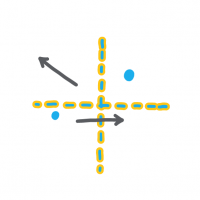5.4.1 Procedural principles
The procedural principles explain how science diplomacy needs to be organised to get a chance to be successful, that is, productive and constructive. They are applicable in situations where the science diplomacy activity can be expected to be collaborative, i.e. in societal-challenge-oriented situations. It is built on the understanding that national, protectionist interests do not contribute to solving the challenges global society faces.
| Principle | Description: “Science diplomatic activities should…” | Key questions | Example |
|
SENSITIVITY |
Respect the specific political, socio-economic and environmental context they are designed for and be able to adapt to changes in them. | · Who are the main stakeholders? · What is the specific (geo-)political, scientific and natural-environmental context? | Dutch water diplomacy: The Netherlands benefit from their longstanding experience with and traditional expertise on all aspects of water management. (Tomalová et al. 2020; Geography) |
|
INCLUSIVENESS |
Be aware of different degrees of inclusiveness vs. exclusiveness and that inclusion is a political choice and part of the diplomatic game, too. Where useful, involve a broadly representative portion of the relevant scientific and diplomatic communities. | · Who and what needs to be in/out of the envisioned activity? · How should inclusion and exclusion be balanced to ensure effectiveness of the activity? | SESAME Synchrotron: see Lesson 7.5 |
|
TRANSPARENCY |
Be appropriately visible to enable monitoring and accountability activities by observing communities, thereby increasing the legitimacy of the activity. | · Which aspects of the activity should be openly accessible? To whom? | Decisions by national ministries: They have their own decision making processes which can obstruct quick responses and transboundary activities. (Flink 2020a; Values, Interests) |
|
DELIBERATION |
Encourage mutual understanding of actors’ perspectives and needs as well as of the problem definition, the disciplinary and interdisciplinary knowledge required (incl. probing for other relevant scientific disciplines) and common narratives for the support of science diplomacy processes. | · Which different perspectives exist concerning the planned activity? · How can consensus be achieved about the problem definition, scope and acceptability of solutions? | Consensual problem narratives simplify cooperation: Framing of a water issue as a problem of water quality or of water as a scarce and contested resource makes a difference in how easily cooperation is achieved. (Tomalová et al. 2020) |
|
RECIPROCITY |
Foster an attitude of understanding and cooperativeness leading stakeholders to trust that each actor participating in the activity contributes to addressing grand challenges in roughly equivalent ways according to their abilities, be it through knowledge or other resources. | · What are you willing to contribute and what do you expect your peers to contribute to the activity? · How do you achieve equivalent contributions? | The trade-off between competition and cooperation: Pursuing common interests is not always the objective of science diplomacy activities. (Degelsegger-Márquez 2020; Mayer 2020) |
|
COMPLEMENTARITY & MANOEUVRABILITY |
Build on stakeholders’ strengths to balance out others’ weaknesses and embed them in governance arrangements that leave enough room to manoeuvre for these strengths to flourish. | · What are the relevant stakeholders for the planned activity? · What are they good at and which weaknesses can be complemented? | Soft power characteristics of Open Science: In the transition phase towards an Open Science system, restricting scientific publications in subscription journals can reduce scientists’ room to manoeuvre. (Mayer 2020) |
|
LEGITIMACY |
Strive for the mutual acceptance of shared “rules of the game” in the interaction space, respecting participating stakeholders’ expertise and framings. Science Diplomacy activities should enable ‘democratic quality’ of proposed and implemented mechanisms, processes and solutions. | · How does the planned activity contribute to or threaten stakeholders’ core values? · Through which processes can the planned activity increase its legitimacy? | ‘Science Diplomacy’ as a label: Strategic avoidance of labelling activities as ‘Science Diplomacy’, can in some cases make more sense, e.g. health diplomacy, cyberdiplomacy or water diplomacy (Kadlecová et al. 2020; Šlosarčík, Meyer, and Chubb 2020; Tomalová et al. 2020) |
|
ALIGNMENT |
Address problems on the lowest, i.e. most local and concrete, appropriate policy/instrumental level while coordinating all involved scales (temporal, spatial and administrative), governance dimensions (horizontal and vertical) and epistemic communities. | · On which level is the activity best suited to be implemented? · How can all influential stakeholders be aligned to maximize the activity’s impact? | Crisis response time reduction: Response time to crises, e.g. cyber attacks or infectious disease outbreaks, can be reduced, if there are appropriate management systems in place (Kadlecová et al. 2020; Ravinet, Cos, and Young 2020; Šlosarčík, Meyer, and Chubb 2020)) |
|
EVALUATION |
Be reflective and facilitate learning throughout the process. | · What does the performance of the activity teach us? · Are we satisfied with the activity’s performance? | Mutual Learning Exercise on Open Science: It was created specifically to learn from the way open science was being implemented, what went well and what could be improved or accelerated. (Mayer 2020) |








